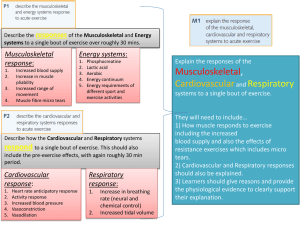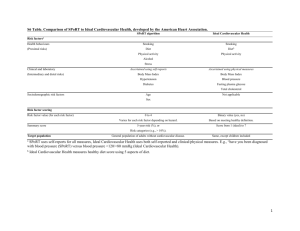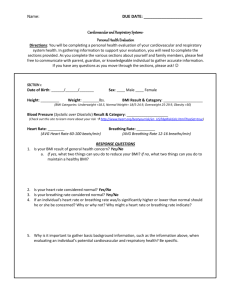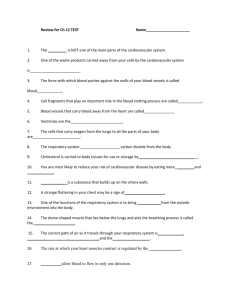Type of joint - haringey6sport
advertisement
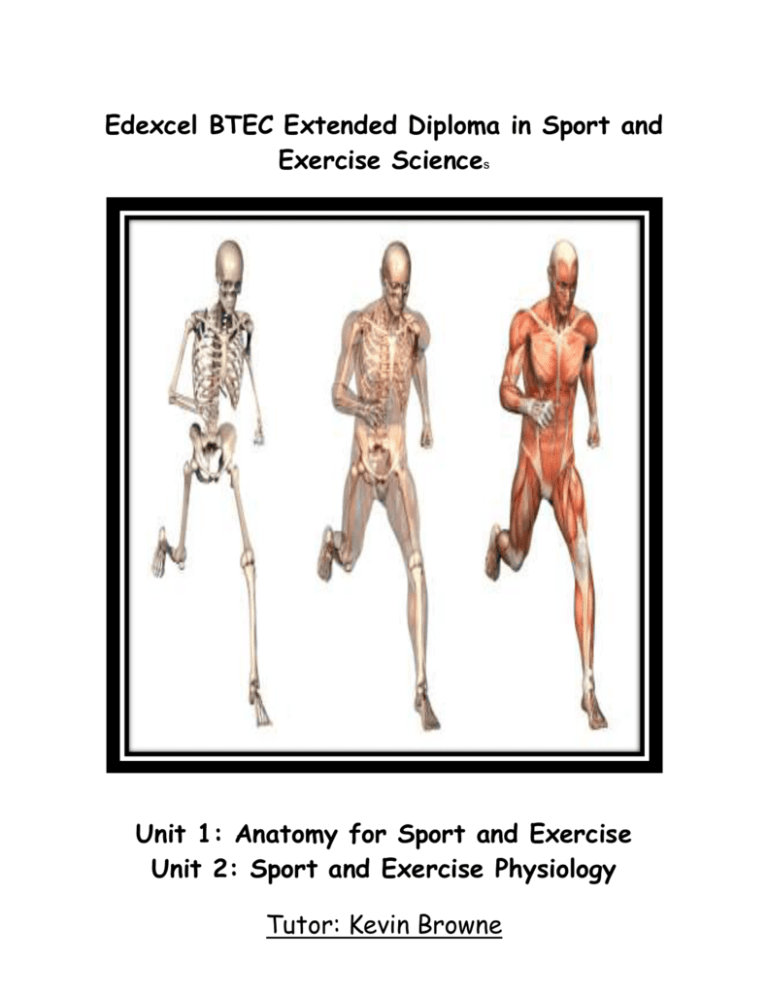
Edexcel BTEC Extended Diploma in Sport and Exercise Sciences Unit 1: Anatomy for Sport and Exercise Unit 2: Sport and Exercise Physiology Tutor: Kevin Browne Programme Title: BTEC Extended Diploma in Sport & Exercise Sciences YR1 Task 1: The cardiovascular system and its responses to exercise Students' Name: Date Set: 30/09/10 Assessors' Name: Kevin Browne Late Submission: Yes / No First hand in date: Final hand in date: Unit 1 & 2 21/10/10 Friday 18th December 2010 Learning outcomes Unit 1 –know the structure and function of the cardiovascular system Unit 2– Know and investigate the initial responses of the body to exercise Specific Objectives To achieve a pass grade the evidence must show that the learner is able to: Unit Criteria Objective Unit 1 (P6) Describe the structure and function of the cardiovascular system Unit 1 (P7) Describe the structure and function of the respiratory system Unit 2 (P1) Investigate the initial responses of the cardiovascular system and respiratory systems to exercise Unit 2 (P2) Describe the initial responses of the neuromuscular and energy systems to exercise Tick when completed To achieve a merit grade in addition to the criteria of a pass the evidence must show that the learner is able to: Unit Criteria Objective Unit 1 (M4) Explain the function of cardiovascular system Unit 1 (M5) Explain the function of the respiratory system (M1) Explain the initial responses of the cardiovascular, respiratory, neuromuscular and energy systems to exercise Unit 2 Tick when completed To achieve a Distinction grade in addition to the criteria of the Merit the evidence must show that the learner is able to: Unit Unit 2 Criteria Objective (D1) Analyse the initial responses of the cardiovascular, respiratory, neuromuscular and energy systems to exercise Tick when completed You are a qualified gym instructor working in the local area. The manager of the gym has been impressed with your work and has asked you to deliver some training to a number of trainee gym instructors. He has asked you to highlight the following information Task One – In a report format a) Describe the Structure of the Cardiovascular System, include the following information: i. The Heart ii. Blood Vessels iii. The Blood (Part P6) b) Explain the Function of the Cardiovascular System (Part, M4) Task 2 a) Describe the Structure of the Respiratory System (Part P7) b) Describe (part P7) and Explain (Part M5) the Function of the Respiratory System, include the following information: i. Transport ii. Mechanisms of Breathing including respiratory volumes Task 3 For task 3 you will need the results from the practical session. Compare the readings recorded and describe the initial responses observed, and those that would be expected. (P1, P2) In your answer you need to include: The cardiovascular and respiratory systems (HR, stroke volume, blood pressure, cardiac output and breathing rate) The neuromuscular and skeletal systems (nervous control of muscles) The energy systems To meet the M1 criteria you must explain the initial responses observed, and those that would be expected. To meet the D1 criteria you must analyse the initial responses observed, and those that would be expected (including why each process takes place) Internal verification: Date: Signature: I certify that the attached work is original and my own work: …………………………………………………… Student Signature Unit 1 – The cardiovascular system and its responses Assignment 1 Student Final Hand in Date Feedback (P6) Describe the structure and function of the cardiovascular system (P7) Describe the structure and function of the respiratory system (M4) Explain the function cardiovascular system of the (M5) Explain the respiratory system of the function 1st draft (met/refer) Final draft (met/refer) Assignment 1 Unit 2: The cardiovascular system and its responses Final Hand in Date Feedback (P1)Investigate the initial responses of the cardiovascular system and respiratory systems to exercise (P2) Describe the initial responses of the neuromuscular and energy systems to exercise (M1) Explain the initial responses of the cardiovascular, respiratory, neuromuscular and energy systems to exercise (D1) Analyse the initial responses of the cardiovascular, respiratory, neuromuscular and energy systems to exercise DO NOT THROW AWAY YOUR MARKED FIRST DRAFT. YOU MUST SUBMIT THIS WITH YOUR UPGRADED WORK 1st draft (met/refer) Final draft (met/refer) Programme Title: BTEC Extended Diploma in Sport & Exercise Sciences YR1 Assignment 2 Musculoskeletal system and the physiological response to steady state exercise and fatigue Students' Name: Date Set: 01/11/10 First hand in date: Final hand in date: Assessors' Name: Kevin Browne Late Submission: Yes / No 19/11/10 Friday 18th December 2010 Unit 1 and 2 Learning outcomes Unit 1 – know the structure of the skeletal system Unit 2 – Know how the body responds to steady state exercise Specific Objectives To achieve a pass grade the evidence must show that the learner is able to: Unit Criteria Objective Unit 1 (P1) Describe the structure and function of the skeletal system Unit 1 (P2) Describe the different classifications of joints and the range of movement available at each Unit 1 (P3) Identify the location, function origin and insertion of major muscles Unit 2 (P3) Investigate how the cardiovascular and respiratory systems respond to steady state exercise Unit 2 (P4) Describe how the neuromuscular and energy systems respond to steady state exercise Unit 2 (P5) Describe fatigue and how the body recovers from exercise Tick when completed To achieve a merit grade in addition to the criteria of a pass the evidence must show that the learner is able to: Unit Criteria Objective Unit 1 (M1) Explain the different classifications of joints and the range of movement available at each Unit 2 (M2) Explain how the cardiovascular, respiratory, neuromuscular and energy systems respond to steady state exercise Unit 2 (M3) Explain fatigue and how the body recovers from exercise Tick when completed To achieve a Distinction grade in addition to the criteria of the Merit the evidence must show that the learner is able to: . Tick when completed Unit Criteria Objective Unit 1 (D1) Compare and contrast the different classifications of joints and the range of movement available at each (D2) Analyse how the cardiovascular, respiratory, neuromuscular and energy systems respond to steady state exercise Unit 2 Scenario The gym manger was very impressed with the training and the feedback that he received and has asked you to deliver another training session. This time he would like you to focus on the skeletal system, steady state exercise and fatigue Task 1 – Produce a booklet a) Complete the attached diagram of the skeleton and name the bones. Distinguish with colours the axial and appendicular skeleton. (Part P1) b) Describe the five classifications of bones and identify the names of each bone in that group. Design a table like below to show your answers. (Part P1) 1 2 3 4 5 c) In a report describe the six main Functions of the Skeletal System (Part P1) Task 2 - In a report format The joints are categorised in accordance to the amount of movement they allow. In a report describe in detail the three different categories of joints; use images to help illustrate your answers. (Part P2) a) There are 6 types of synovial joints, describe which movements are allowed at each and how the structure at each joint allows this to occur. You may wish to use sporting example to illustrate your answer. Use the format below to help you. (Part P2) Type of joint Bones that make the joint Movements Sporting examples b) Using the table in task 2b to help you with your answer write a report, which explains (M1) and compares (similarities) and contrast the different classifications of joints and the range of movement available at each one (D1) TASK 3 Part A a) For all the major skeletal muscles identify the information below: i. The location of each one (16 muscles) ii. The Function of skeletal muscle iii. The Origin and Insertion (16 muscles) (P3) Design an information sheet for the trainees describing to your them how the body’s systems respond to steady-state exercise (P3, P4) In your answer you should include: Heart rate, stroke volume, blood pressure, cardiac output, re-direction of blood flow, breathing rate, change of tidal volume, oxygen dissociation curve and methods of thermoregulation Changes to nervous control Energy systems employed To meet the M2 criteria you must explain how the body’s systems respond to steady-state exercise. (M2) To meet the D2 criteria you must analyse how the body’s systems respond to steady-state exercise. (D2) Part B Describe (P5) or explain (M3) fatigue, and how the body recovers from exercise. Include in your answer: Factors that contribute to fatigue Depletion of energy sources The effect of waste products Neuromuscular fatigue How the body recovers from exercise Internal verification: Date: Signature: I certify that the attached work is original and my own work: …………………………………………………… Student Signature Assignment 2 Unit 1 – Anatomy for Sports and Exercise Student Final Hand in Date (P1)Describe the structure and function of the skeletal system (P2)Describe the different classifications of joints and the range of movement available at each (P3) Identify the location, function origin and insertion of major muscles (M1) Explain the different classifications of joints and the range of movement available at each (D1) Compare and contrast the different classifications of joints and the range of movement available at each Feedback 1st draft (met/refer) Final draft (met/refer) Assignment 2 Unit 2: Sport and Exercise Physiology Final Hand in Date Feedback (P3)Investigate how the cardiovascular and respiratory systems respond to steady state exercise (P4)Describe how the neuromuscular and energy systems respond to steady state exercise (P5)Describe fatigue and how the body recovers from exercise (M2) Explain how the cardiovascular, respiratory, neuromuscular and energy systems respond to steady state exercise (M3) Explain fatigue and how the body recovers from exercise (D2) Analyse how the cardiovascular, respiratory, neuromuscular and energy systems respond to steady state exercise DO NOT THROW AWAY YOUR MARKED FIRST DRAFT. YOU MUST SUBMIT THIS WITH YOUR UPGRADED WORK 1st draft (met/refer) Final draft (met/refer) Programme Title: BTEC Extended Diploma in Sport & Exercise Sciences YR1 Effects of long term exercise Assignment 3: on the body and types of muscle Students' Name: Date Set: Assessors' Name: Kevin Browne Late Submission: Yes / No First hand in date: Final hand in date: Unit 1 & 2 23/11/10 13/12/10 Friday 18th December 2010 Learning outcomes Unit 1: know the structure and function of the muscular system Unit 2 : know how the body adapts to long term exercise Specific Objectives To achieve a pass grade the evidence must show that the learner is able to: Unit Criteria Objective Unit 1 (P4) Describe the different types of muscle and the fibre types Unit 1 (P5) Describe the process of muscular contraction and the different types of contraction Unit 2 (P6) Describe how the cardiovascular and respiratory systems adapt to long term exercise Unit 2 (P7) Describe how the neuromuscular, energy and skeletal systems adapt to long term exercise Tick when completed To achieve a merit grade in addition to the criteria of a pass the evidence must show that the learner is able to: Unit Criteria Objective Unit 1 (M2) Explain the properties of the different types of muscle and the different muscle fibre types Unit 1 (M3) Explain how muscles produce movement and the different types of contraction (M4) Explain how the cardiovascular, respiratory, neuromuscular, energy and skeletal systems adapt to long term exercise Unit 2 Tick when completed To achieve a distinction grade in addition to the criteria of a pass and merit the evidence must show that the learner is able to: Unit Criteria Objective Unit 1 (D2) Compare and contrast the properties of the different types of muscle and the different muscle fibre types Unit 2 (D3) Analyse how the cardiovascular, respiratory, neuromuscular, energy and skeletal systems adapt to long term exercise Tick when completed Scenario As a qualified gym instructor many clients will ask you various questions related to how their body reacts to exercise and whether these reactions are normal. They are also keen to learn why they are only able to exercise for certain periods of time. In order to perform your role effectively, you must carry out research prior to the start of your new job so that you are able to knowledgeably answer your client’s questions. Task 1: In a report format For two different athletes describe the adaptations of the body’s systems to long-term (chronic) exercise and their sport. You can choose from the following athletes: Marathon runner High jumper 200m sprinter Triple jumper Javelin (P6, P7) In your answer you need to include: An exercise period of at least 8 weeks The cardiovascular and respiratory systems The neuromuscular and skeletal systems The energy systems Aerobic exercise and the effects Anaerobic exercise and the effects To meet the M4 criteria you must explain the adaptations of the body’s systems to long-term (chronic) exercise and their sport. (M4) To meet the D3 criteria you must analyse the adaptations of the body’s systems to longterm (chronic) exercise and their sport. (D3) Task 2 Part A Describe the structure of the three main types of muscle tissue. Once this has been completed, design a table that highlights the properties of all three. (Part P4, Part M2) Describe (Part skeletal muscle. i. ii. iii. P4) and explain (Part M2) the three fibre types that can be found in the To help you with you answer include the following information for each type: Characteristics Types of Sport they are associated with Force Production (Part P4) To meet the distinction criteria you must compare and contrast the properties of the different types of muscle and different muscle fibre types. (D2) Part B a) Describe/Explain how movement is produced through the Sliding Filament Theory (Part P5, Part M3) b) Describe/Explain the differences between: i. Antagonistic Pairs ii. Fixator iii. Synergists (Part P5, Part M3) c) Describe/Explain the main types of Muscle Contractions and include what kinds of sporting activities these contractions can be used in (Part P5, Part M3) The grade awarded will reflect the amount of information that has been given. Internal verification: Date: Signature: I certify that the attached work is original and my own work: …………………………………………………… Student Signature Assignment 3: Effects of long term exercise on the body and types of muscle Unit 1 – Anatomy for Sport and Exercise Student Final Hand in Date (P4) Describe the different types of muscle and fibre types (P5) Describe the process of muscular contraction and the different types of contraction (M2)explain the properties of the different types of muscle and the different muscle fibre types (M3) Explain how the muscles produce movement and the different types of contraction (D2) compare and contrast the properties of the different types of muscle and the different muscle fibre types Feedback 1st draft (met/refer) Final draft (met/refer) Task 3: Effects of long term exercise on the body and types of muscle Unit 2: Sport and Exercise Physiology Final Hand in Date (P6) Describe how the cardiovascular and respiratory system adapt to long term exercise (P7) describe how the neuromuscular energy and skeletal systems adapt to long term exercise (M4) explain how the cardiovascular, respiratory, neuromuscular, energy and skeletal systems adapt to long term exercise (D3) analyse how the cardiovascular, respiratory, neuromuscular, energy and skeletal systems adapt to long term exercise Feedback 1st draft (met/refer) Final draft (met/refer) Textbooks and Resources ÷ Blakey P – The Muscle Book (Himalayan Institute Press, 2000) ISBN 0893891827 ÷ Clancy J and McVicar A – Physiology and Anatomy: A Homeostatic Approach (Edward Arnold, 1995) ISBN 0340631902 ÷ Kapit W and Elson L M – The Anatomy Colouring Book – 2nd Ed (Harper Collins, 1993) ISBN 0064550168 ÷ Kingston B – Understanding Joints (Stanley Thornes, 2000) ISBN 0748753990 ÷ Kingston B – Understanding Muscles (Stanley Thornes, 1998) ISBN 0748743189 ÷ Ross J S and Wilson K J W – Anatomy and Physiology in Health and Fitness (Churchill Livingstone, 1996) ISBN 0443051569 ÷ Seeley R R, Stephens T D and Tate P – Anatomy and Physiology (McGraw Hill, 2000) ISBN 0071179992 ÷ Stone R J and Stone J A – Atlas of Skeletal Muscles (McGraw 1999) ISBN 007116992X BN011709 – Guidance and units – Edexcel Level 3 BTEC Nationals in Sport and Exercise Sciences– Issue 1 – June 2002 ÷ Thompson C W and Floyd R T – Manual of Structural Kinesiology (McGraw, 1988) ISBN 0071181911 Websites ÷ Human Anatomy – emuseum.mnsu.edu/biology/humananatomy/index.html ÷ Human Anatomy Online – www.innerbody.com ÷ The Visible Human Project – National Library of Medicine – www.nlm.nih.gov/research/visible/visible_human.html ÷ Virtual Hospital: Atlas of Human Anatomy in Cross Section www.vh.org/providers/Textbooks/HumanAnatomy/CrossSectionAtlas.html
